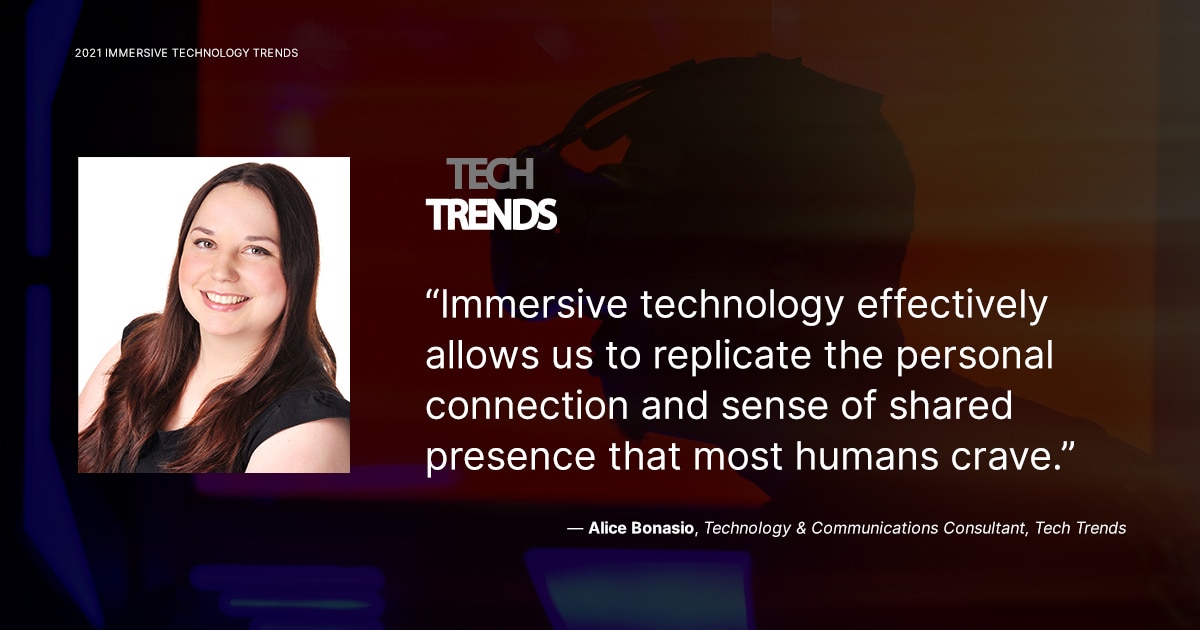How Immersive Technologies are helping us reimagine personal interactions in a post-COVID world.
At the start of 2020 (remember those giddy, carefree times before the pandemic struck?) Unity asked more than a dozen industry experts – including yours truly – to share their thoughts on how immersive technologies would be embraced for a report entitled Top 2020 Trends: Enterprise AR & VR.
All signs were pointing to 2020 being a breakout year for immersive tech, and, as it turned out, this was one of the few things not to have been derailed by COVID-19.
With the widespread need for social distancing and shift towards remote work, companies turned to immersive technology tools such as real-time 3D, AR, and VR to connect employees for remote collaboration, replace events and exhibitions, and allow teams to work in offices, labs, and sites from afar. As the need to support employees remotely grew more urgent, this was reflected in the accelerated adoption of XR across the board.
Microsoft, for example, has seen a 13x increase in remote assistance usage over the past 12 months, and Unity believes that this general trend is likely to continue in 2021.
All signs were pointing to 2020 being a breakout year for immersive tech, and, as it turned out, this was one of the few things not to have been derailed by COVID-19 Share on XSome of the key findings from the report include:
The use of mixed reality will expand to enable more human connections
Mixed reality has traditionally been used to aid in task completion, however, the pandemic has sparked the need for tools that mimic human connection and proximity to create more productive work environments and collaboration.
Cross-functional collaboration across immersive media will grow
2020 has seen more users looking for ways to collaborate remotely from multiple geographic locations, using media that mimic real life. Expect that to continue into 2021.
VR will prove even more useful in the workplace
The disruptions of COVID-19 have led many to look for creative ways to solve new and old problems across the workplace, such as keeping skills fresh, engaging learners without in-person training, improving employee productivity, and fostering collaboration and connection among teams.
Jeremy Dalton, Head of AR/VR PwC believes that in 2021 and beyond we will see a wider range of businesses across numerous industries become more comfortable with emerging technologies that they would otherwise have left on the sideline until pressured to innovate.
While computers will never fully replace the value of in-person connection, Fleckenstein believes there is a tremendous opportunity for more immersive collaboration, and 2021 will see mixed reality evolve beyond task completion and emerge as the ideal medium for human connection.
As the need to support employees remotely grew more urgent, this was reflected in the accelerated adoption of XR across the board Share on XFuturist and author Cathy Hackl, predicts volumetric video will be a key factor in sustaining this evolution and widespread adoption.
Volumetric video, she explains, can help companies overcome pain points caused by the sudden shift to remote work, since the technology makes it possible to record employees, projects, or scenarios in three dimensions, instead of digitally rebuilding them from scratch for virtual reality simulations.
“The digital video can then be edited and manipulated to be viewed on everything from flat screens to virtual reality simulations,” she explains, adding that experiencing something in 3D with real-life physical movement is shown to increase viewers’ retention of the information being taught.
According to Matt Fleckenstein Senior Director, Mixed Reality at Microsoft, the ROI for firstline workers when adopting mixed reality in enterprise has been significant:
“We’ve seen 90% of touch labor eliminated, errors reduced to zero, and increased employee satisfaction.”
Elizabeth Baron, Enterprise Solutions Executive at Unity Technologies, says “Immersive realities provide probability spaces for enterprises to study any potential reality, or the art of the (im)possible,” with a host of relevant data that is brought to life and experienced rather than merely presented.
“Storytelling with immersive XR can simultaneously bring a spreadsheet to life for an artist and bring a design to life for an engineer,” she explains.
You can access the e-book for free here

For companies looking to get into Immersive technologies our VR Consultancy service offers comprehensive support in strategic deployment of Virtual, Augmented and Mixed Reality
Alice Bonasio is a VR Consultant and Tech Trends’ Editor in Chief. She also regularly writes for Fast Company, Ars Technica, Quartz, Wired and others. Connect with her on LinkedIn and follow @alicebonasio on Twitter.









